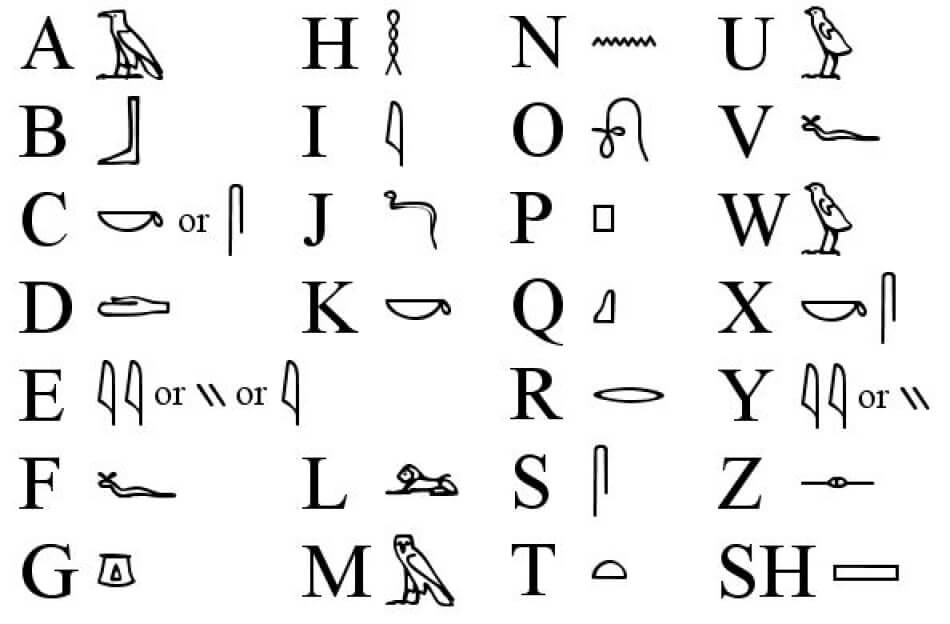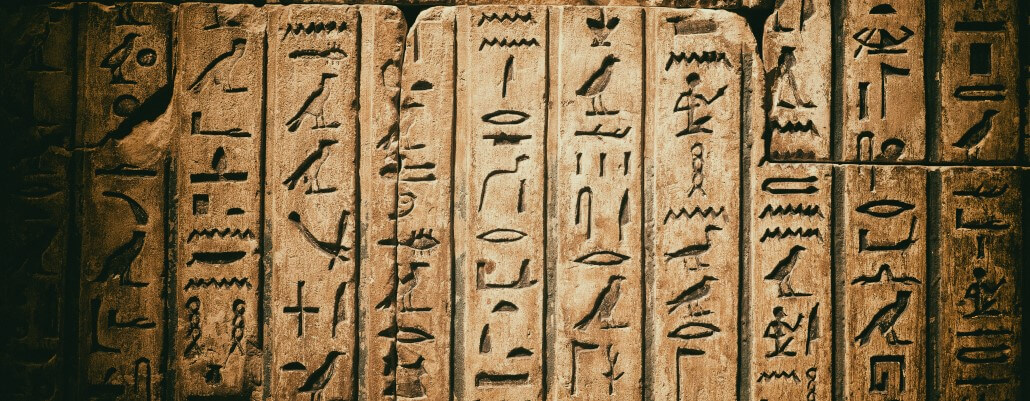Explore Ancient Egypt
- Ancient Egypt Facts
- Ancient Egypt Timeline
- Hieroglyphics
- Egyptian Gods & Goddesses
- Pharaohs
- Notable People (Cleopatra etc.)
Writing! It’s an amazing thing if you think about it. You look at some squiggles on a page or screen (exactly like you’re doing right now) and pictures, shapes and sounds magically appear in your mind! Incredible. The invention of writing is also one of the most important developments in human history.
This is because writing is a way of storing and preserving information. It means that when someone dies, all of their knowledge and experience doesn’t die with them. Just as long as they wrote it all down!
Around 5,000 years ago, people in Ancient Egypt developed a particularly beautiful form of writing called hieroglyphics. But it’s not just beautiful; it’s fascinating. Don’t believe me? Read these Egyptian hieroglyphic facts to see for yourself.
1. Egyptians never called them hieroglyphics.
Hieroglyphics are one of the most famous things about Ancient Egypt. But we actually get the term from the (slightly less) Ancient Greeks. When they saw the beautiful and elaborate symbols carved onto tombs and walls, they assumed they must be religious writings. For that reason, they called them hiero (meaning holy or sacred) glypho (meaning writing or carving). In a way they were right. The Egyptians called them medu netjer – which means the gods’ words. And if you’re wondering whether you should be calling them hieroglyphs or hieroglyphics, don’t worry about it. Both are correct!
2. Hieroglyphics might have been called the gods’ words, but they were used for all sorts of things.
Romantic poems, agreements with other countries, tax returns and even shopping lists have all been found written in hieroglyphs.
3. There were over a thousand different hieroglyphic symbols.
Some symbols represented individual words, some represented sounds and others were used to clarify what had come before. It makes learning the 26 letters of our alphabet seem like a doddle doesn’t it?

4. There were actually three separate types of Ancient Egyptian writing.
The original hieroglyphs were too elaborate and time-consuming to use on a daily basis. Over the years, two simpler forms of writing were developed. These are known as hieratic and demotic scripts.
5. Hieroglyphic writing had no spaces between words and absolutely no punctuation!
It could also be written from top to bottom, left to right, bottom to top or right to left! The direction in which the human and animal figures faced told the reader which way to read.
Imaginehowgooditwouldbetonothaveyourteachercorrectyourpunctuation!
6. Hieroglyphics weren’t just carved into walls.
They have been found on wood, metal, bone, clay, ivory, pottery, leather and, above all, papyrus. This is an early form of paper made from reeds. It was incredibly useful for storing and transporting information. It gave Egypt such an advantage over their enemies that the secret of how papyrus was made was closely guarded.
7. Egyptian gods fell out over writing!
According to Ancient Egyptian beliefs, the god Thoth created writing in order to improve the Egyptian people’s wisdom and memory. The god Rey believed it would do the opposite. Despite Rey’s objections, Thoth gave it to them anyway! As a result, the Ancient Egyptians who could write, known as the scribes, were greatly respected for having god-like powers.
8. There were serious perks if you mastered writing and became a scribe.
The government, the army and the priesthood all needed people who could write. That is why scribes didn’t have to pay taxes, fight in the army or do any manual labour.
9. Egyptian hieroglyphs were used for a VERY long time.
Hieroglyphs dating back to around 3,200 BCE were discovered in the Ancient Egyptian city of Elkab. The most recent were carved into a temple at Philae in 394 CE. We got together at JellyQuest HQ and calculated that means hieroglyphics were used for…ages! Or around 3,600 years if you want to be more specific.
10. Nobody could understand Egyptian hieroglyphs for a VERY long time.
As Christianity grew in popularity in Egypt, hieroglyphs began to be replaced by Roman and Greek alphabets. In 391 CE, the last pagan (pre-Christian) temples were closed. Before long, there was no one left who could read the hieroglyphics and their meanings were a complete mystery for over 1,500 years!
11. Hardly any Ancient Egyptians could understand hieroglyphics.
It is perhaps not surprising that the understanding of hieroglyphs died out when so few people could actually understand them. Towards the end of the Ancient Egyptian civilisation, they were only used and understood by priests – who made up a fraction of the total population,
12. We’ve got Napoleon to thank for unlocking the mystery of Egyptian hieroglyphs. Kind of.
In 1799 CE, some of the French Emperor Napoleon’s soldiers discovered a stone slab in the Egyptian town of Rashid (also known as Rosetta). The slab, which was soon called the Rosetta Stone, was inscribed with three different types of writing; hieroglyphics, demotic and ancient Greek. A French linguist called Jean-Francois Champollion realised it was the same message written in three different languages. And because he could read ancient Greek, he was able to work out what the hieroglyphs stood for too! After over 1,500 years, people could finally read hieroglyphics again!
13. It is thanks to hieroglyphics that we know so much about Ancient Egypt.
Compared to other Ancient civilisations, the Egyptians wrote lots of things down. So even though the people and ways of life have long since died away, our understanding of them lives on. All thanks to hieroglyphics!
14. Hey maths fans! It wasn’t just words Egyptians had hieroglyphs for.
There was also a decimal system for representing numbers that went all the way up to a million.

15. Egyptian hieroglyphs may be the most beautiful writing system – but it’s not the oldest.
The writing system created by the Sumerian civilisation is even older than Egyptian hieroglyphics. In fact, the Egyptians may well have got the idea of writing from the Sumerians. Or maybe the god Thoth really did give it to them!
See! We told you hieroglyphs were fascinating. But, just like the scribes when they carved the hieroglyphics onto the temple walls, you’ve only just scratched the surface. Dig a bit deeper and see what else you can learn about this beautiful and intriguing writing system.
Hieroglyphics FAQs
What are hieroglyphics?
Hieroglyphics were used by Ancient Egyptians as a form of writing. Instead of words, like we use today, they used pictures and symbols. The Egyptians called them medu netjer – which means the gods’ words.
How many hieroglyphics are there?
There were over a thousand different hieroglyphic symbols. Some symbols represented individual words, some represented sounds and others were used to clarify what had come before.
Who invented hieroglyphs?
The Ancient Egyptians invented the hieroglyphics. We get the term from the Ancient Greeks, who called them hiero (meaning holy or sacred) glypho (meaning writing or carving). As such, hieroglyphs essentially means ‘sacred carvings’.
Who do hieroglyphics look like?
Hieroglyphics consist of pictures and symbols. For example, a picture of a bird can represent the sound of the letter ‘a’. whereas a bee can represent honey.
What is the difference between hieroglyphs and hieroglyphics?
Put simple, both terms are correct. Some refer to a single symbol as a hieroglyph, and the entirety of them as hieroglyphics.
